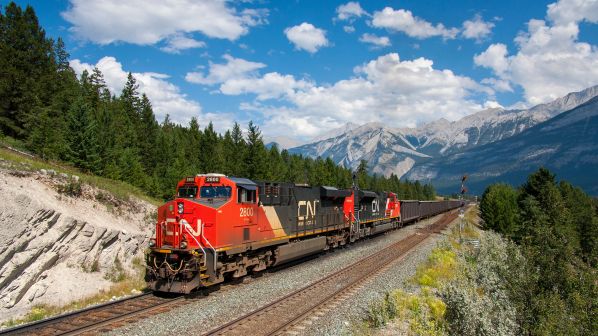THE current version of Precision Scheduled Railroading (PSR), which we refer to as 1.0, has produced measurable financial, operational and service improvements for railways. Yet, some internal growing pains continue, accompanied by shockwaves absorbed by shippers, non-PSR railways, partners, advocates and policymakers.
PSR 1.0 is widely accepted as the benchmark of financially sound railways and is starting to materially change the investment landscape. North American infrastructure funds are getting involved in the railway renaissance. In July 2019, US financial services company Morningstar reported that PSR is “the surest path to the best operating ratio (OR), a key industry measure of profitability.”
To date, PSR has been applied to some North American Class 1 railways but has yet to be applied widely to Class 2, Class 3, short line, tenant and passenger railways. This gap in PSR deployment represents about 40% of North American route-km, but there is both excitement and apprehension in expanding PSR into these new areas.
Escalating trade disruptions, rail strikes, blockades, weather events and the Covid-19 pandemic have highlighted the urgency to make supply chains more resilient. Transport supply chains are under increasing pressure to meet demand while keeping inventory levels low. The weaknesses in the international supply chains have also been exposed, and the escalating domestic transport turmoil demonstrates the need for end-to-end approaches, standards, solutions, and greater service level accountability and safety.
It is time for the next generation of PSR to provide the means for implementing and scaling PSR for mainstream adoption - not just within individual railways, but across railways and the entire transport ecosystem, globally, including a supply chain that is becoming more integrated, nimble and transparent. At its core, it is about providing customer service reliably, predictably, effectively and safely; thereby producing other benefits, such as profitability and future proofing in the face of rapid change.
PSR 1.0 is an origin-to-destination method of managing a railway. It challenges traditional asset utilisation and service quality practices and is geared toward optimising existing assets. It is based on operating fixed train schedules that optimise train load and yield and improve service accountability down to the wagonload level.
The key tenets of PSR 1.0 are:
- provide service: doing what you say you are going to do
- control costs: eliminate unnecessary costs
- optimise assets: use assets more efficiently and productively
- operate safely: safety is the top priority, and
- develop people: cultivate the best team.
PSR 1.0 has driven improvements in line and yard capacity, productivity, asset fluidity and costs. With the impressive improvements in operating ratios, PSR is currently widely accepted in investment and finance circles as the benchmark of financially sound railways.
But PSR 1.0 has its limits. Costs can only be cut so far before the cost base needs to be transformed. PSR 1.0 is focused on individual railways and their internal operations, optimising assets and reducing costs while trying to support new business ventures that may not be mature. For other transport players, this creates downstream impacts, with partners such as Class 2 and 3 railways having to step up as “shock absorbers.” Service quality for customers has ranged from painful marked degradations to unprecedented improvements.
PSR 2.0
It is time for PSR to evolve and scale across the rail network and its partners, driving greater business value and efficiency gains. To achieve this, we believe that PSR 2.0 should be a constantly evolving purpose and data-driven origin-to-destination management view of a transport ecosystem in which railways commit to reliable service, cost control and asset optimisation. PSR 2.0 should be anchored by an operating methodology and structure based on leveraging optimal revenue generation and growth strategies.
The five pillars of PSR 1.0 are foundational, timeless and meaningful to everyone, regardless of role. They provide a decision-making framework for implementing PSR 2.0. Here are five guiding principles to take PSR to the next level:
- reward entrepreneurial culture: everyone is innovative, resourceful and creates value
- exercise business rigour and relevancy: precisely match services (supply) with markets (demand) and business objectives or obligations
- forge productive partnerships: strengthen performance and viability
- safeguard end-to-end flow: accounting for downstream impacts across systems, and
- foster a learning organisation: continual mastery and improvement.
These guiding principles serve as enhancers to increase value; accelerators, where progress occurs faster and more effectively; and sustainers to maintain gains.
PSR 2.0 transcends PSR 1.0 by embracing entrepreneurship and partnerships across railway and related transport systems. It expands PSR 1.0 to include revenue generation and growth strategies. Productive partnerships that go beyond individual railways to extend across the rail industry and embrace other transport players are key.
PSR 2.0 requires an entrepreneurial culture, creating a system of shared values, beliefs and norms. It includes embracing ingenuity, valuing creative people and cross-pollinating functional disciplines and industry sectors. PSR 2.0 also depends on believing that innovation and seizing market opportunities are critical to survival and prosperity, and to dealing with environmental uncertainty, competitors and threats.

In this new mode of operation, it is no longer acceptable to overlook downstream impacts. To date, Class 1 PSR 1.0 adoption has been inward facing: closing yards, rationalising assets, and rightsizing service, leaving Class 2 and 3 railways to deal with the impacts and bear the burden of being shock absorbers. Mitigation results in disproportional costs and changes to delivering agreed first-mile and last-mile service. With PSR 2.0, the changes would be proactively planned and executed with a view of first-mile/last-mile cause-and-effect to ensure smooth flow throughout the system.
A unified PSR platform is central to PSR 2.0 and its governing processes, policies and technologies. This platform is a mechanism to protect the rail industry’s relevance and future. Well-defined hand-offs among parties and legal entities are vital. All parties earn a seat at the table. They must see the cause-and-effect impacts across the end-to-end system, as opposed to existing in silos.
PSR 2.0 transcends PSR 1.0 by embracing entrepreneurship and partnerships across railway and related transport systems.
The platform allows for better responsiveness and market relevance. Furthermore, a unified PSR platform with aligned partnerships is an alternative to an exclusive “acquire-and-comply” growth strategy. PSR 2.0 can also facilitate integration following mergers and acquisitions.
The interacting players are Class 1, 2 and 3 railways; passenger operators; air transport, seaports, road hauliers and pipeline operators; and regulators, legislators, unions, and industry groups. First implementers and early Class 1 railway adopters will create the momentum for others, with the unified PSR platform growing and maturing as more adopters engage.
Initial implementations will have PSR 1.0 players adopting basic PSR 2.0. Another transition would include new adopters starting with PSR 2.0 implementation. Over time, as capability matures, the unified platform would be fully established on PSR 2.0. Any laggards, such as those stopping at PSR 1.0, would receive only partial benefits from a PSR 2.0 platform.
PSR 1.0 has been implemented with little consultation with regulators and policymakers, the mandate of which is to protect the transport system, often leaving them to guess what is going on. They heard many concerns, possibly biased, as changes were being made, but had little, if any, basis to properly evaluate and respond, let alone catch up after the fact. With PSR 2.0, public advocacy/partners would be engaged upfront in any change process, properly informed and prepared as the changes begin to roll out. PSR 2.0 would allow them to provide early guidance on regulatory and industry impacts.
When Class 1, 2 and 3 railways construct a commercial Train Service Agreement (TSA) that defines service frequency, interchange locations and dispute resolution mechanisms, it does not always consider the views of all parties involved equally, with Class 2 and 3 railways carrying less weight than a Class 1. TSAs tend to be used to discuss service failures, thereby invoking dispute resolution mechanisms.
PSR 2.0 would add rigour and commitment to the planning and balanced execution of TSAs, rather than focusing on conflict resolution. It would encourage dialogue between those constructing the TSA, demand repeatable service commitments and accountabilities based on facts and data, and uphold agreed ways to measure and monitor performance to allow a response to temporary changes in demand. As a result, all parties would share improved performance and asset efficiency benefits.
Currently, supply chain visibility is generally segmented and does not transcend entities well. Typically, a product coming off the production line in Asia is transported to a port, shipped across the Pacific to a North American port, transported by rail to an inland distribution centre and delivered by road to retail locations. Consequently, there are gaps in the downstream work scope, impairing the ability to make precise decisions. All of this results in lost productivity and opportunities to adapt and respond to operational realities and fluctuations. With PSR 2.0, various roles within the span of influence and control among entities in the supply chain are articulated, agreed, measured, monitored and enforced.
The immediate sweet spot for PSR 2.0’s launch and evolution would be the entry of a Class 2 PSR implementation, while working together with current Class 1 PSR-based railways that are ready to mature to this next level of capability. An optimal cost:benefit balance will begin manifesting across the end-to-end ecosystem. This domino effect will draw in numerous railways, shippers, and public and enterprise advocacy/policy partners.
We believe that waiting for the rising tide of the economy is short-sighted as it could be a long wait, and supply chains could shorten as North America contemplates onshoring and building national capacity in critical areas.
PSR 2.0 provides a unique opportunity to transform the rail industry and the entire transport ecosystem, globally. It has the power to achieve sustainable operational and organisational effectiveness, and profitable growth.
Sonia Bot can be contacted at [email protected] and John Orr at [email protected].

